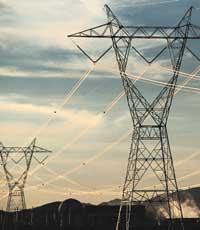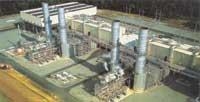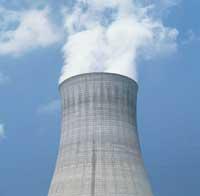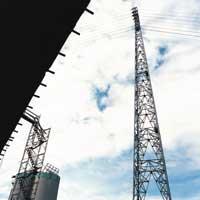Electric sparks of Bizkaia
In the area of Bizkaia there are several projects of electric power production: combined cycle power plants, regasification plant, IGCC... New words that we have often heard lately. Politicians yes, citizens no... But what do they really want to build on our land?

In 1992, the Basque Government defined the planning of the Euskadi 3E-2000 Energy Strategy for the period 1991-2000. Later, in the 1990s, taking into account changes in energy, he revised this strategy and decided to expand it to 2005. The marked target is not slow.
In 1995, 20% of the electricity consumed in the ACBC was produced in it. The second planning proposes to produce 82% of the expenditure made in 2005. The Basque Government expects an investment of 415 billion pesetas (16.6 billion pounds). Most of the investment, above 166 billion pesetas (6.640 million pounds), will go to the production of electricity.
To achieve this goal, the Basque Government is supporting and promoting the participation of various private initiatives. These include the facilities they want to build in the Bizkaia area: combined cycle power plants in Boroa (Amorebieta) and Santurtzi, regasification plant in Zierbena, combined integrated gasification cycle (IGCC) in Abanto and landfill gas valorization plant in Artica (Bilbao). According to the Deputy Minister of Energy of the Basque Government, Javier Aramburu, these projects will allow Basque companies to sell energy at a very competitive price. In addition, it has announced the intention to sell gas externally.
Citizenship is not satisfied
Although all these electric power generation plans are advancing, citizens have shown their opposition. In declarations both on the street and in the offices of various institutions, environmental groups and groups formed to that effect have repeatedly vindicated opposition to the facilities. Perhaps the groups that have searched the most have been the Colectivo del Abra and the Zornotza Bizirik.
Colectivo Abra was born last year. Its aim is to tackle the projects underway in Gran Bilbao, in the surroundings of the Abra bay. In the events and public statements that have been made to date, this collective has criticized several points about the projects. First, the environmental impacts of thermal power plants are mentioned. They denounce that the gases emitted in the combustion process, besides being pollutants, cause climate change, contribute to the heating of the earth and perforate the ozone layer. In addition, they have denounced that environmental studies have not taken into account the synergistic effect of all plants.
On the other hand, it is noted that the methane used as fuel is explosive and polluting and that the transport of this gas is an important investment. Finally, they emphasize that if all the projects of power plants that want to be built in Bizkaia were carried out, 2.5 times more electricity would be produced than would be consumed in the CAPV, so much of it should be sold. The main demand of the Abra collective is to ask the population for energy saving measures. They also consider that cleaner energy sources should be boosted, but not massively, as they are doing with wind energy.
To fight against the thermal power plant they want to build in Zornotza, the Zornotza Bizirik group was created at the end of 2000. Although initially it was in favor, with the passage of time the city council has shown itself contrary to the project. Among the arguments presented to this effect, the issue of land classification stands out. According to the Boroa soil classification, the allowed height is 10 meters and can only be extended for technical reasons. For its part, the managing entity of the project Bizkaia Energy considers that the chimney of 50 meters to build in the central is a technical reason, so it does not have to cause legal problems. However, the City Council considers that it is not only a fireplace, according to the project, most parts of the building have a height greater than 10 meters. J. Minister of Industry of the Basque Government J. Imaz has insisted that if construction conditions are not met, the Irish company ESB will have to look for another place to build the plant.
Meanwhile, the citizens have carried out various mass demonstrations and, in addition to street demands, the Zornotza Bizirik group has been formed by institutions and offices. In fact, the members of the group fear the contamination that a plant of this type can generate and present allegations to the project of the plant. To respond to this and defend the project, ESB's managers published a press release in the newspapers. In it, the Zornotza Bizirik group refutes some of the issues raised in relation to the project and accounts for the modifications agreed upon after the analysis and valuation of the allegations.

These changes include refrigeration. After analyzing the allegations, it was decided to replace water with an air cooling system. This will prevent the reduction of water and the generation of mists by the plant. On the other hand, they indicate that they will use burners with low NOx emissions. As for carbon dioxide, the Boroa plant will emit half of the atmospheric emissions of conventional thermal power plants. Zornotzarras are also concerned about the influence that the building of the central will have on the surrounding landscape, as it will have two towers of 50 meters of height and more than 7 meters of diameter. To address this, project managers say they will try to minimize the impacts on the landscape.
This press release was published in late February. Subsequently, on 27 March, ESB officials held a press conference. In their statements, they indicated that in the coming months a campaign will be carried out to explain the benefits that the plant will report. The press conference has announced that the demand for electric power will increase between 3 and 3.5% and expects to produce 40% of what is consumed in the CAPV in the Amorebieta plant. In any case, after analyzing and discussing all the information about the project, ESB says it will respect the decision of the neighbors of Amorebieta.
That same day, the deputy of the Presidency, José Luis Bilbao, made statements in favor of the central in the General Boards of Bizkaia. In his opinion, the Boroa plant is necessary, adequate and good. However, he said that the Provincial Council of Bizkaia will not do anything against the final decision of the Municipality of Amorebieta.
In relation to this, it should be remembered that in March two reports were published in favor of the Amorebieta plant. On the one hand, the Spanish Ministry of Environment (MIMAM) has considered the Boroa project viable. According to the approved Environmental Impact Declaration, ESB must meet a number of requirements, both before the start of the works and during the construction phase.
On the other hand, there is a report prepared by the Labein laboratory on behalf of the Basque Government. It says that of the four plants that want to be built in Bizkaia, Amorebieta is the one that emits the least nitrogen oxides. According to the report, each of the central chimneys will emit 29 grams of nitrogen oxide per second, while Petronor chimneys will emit 63 grams per second. On the environment, the report highlights the environmental advantages of combined-cycle power plants that use natural gas as fuel versus conventional heat.

The former emit carbon dioxide into the atmosphere 2.8 times less than mineral coal power plants and 2.2 times less than fuel power plants. On the other hand, the study has denied that the concentration of nitrogen oxides in the localities in which plants are to be built will be higher than in others, and that it will depend on the height of the residential areas. Finally, it is noted that the construction of the plant in Boroa assumes that the average annual concentration of nitrogen oxides in Durango will hardly vary, although the construction of power plants in Santurtzi, Artica or in the Abra area.
As soon as the report was made public, members of the Zornotza Bizirik group denounced that carbon dioxide was not mentioned. They also questioned the source of the data used for the preparation of the report and asked whether Labein has conducted his own research or has used the data provided by the company. In any case, it was indicated that they will continue to carry out actions against the plant.
Zierbena regasification plant
The construction of a liquefied natural gas regasification plant and a combined cycle power plant is planned at the Bilbao superport in Zierbena. To carry out this project the Bay of Biscay society was created. The Society has two branches: Bahía de Bizkaia Gas and Bahía de Bizkaia Electricity. The partners of the company are the multinational BP-Amoco, the Basque Energy Agency, Repsol YPF and Iberdrola, all with the same level of participation. According to the project, the works had to begin in November last year and end by the end of 2003.
Most of the liquefied gases come from BP-Amoco deposits in the islands of Trinidad and Tobago and Nigeria, and the rest of Norway and Venezuela. Two of the three methane vessels used for the transport of gas will be carried out in the company La Naval de Sestao and the third will be done by the shipyard of the Puerto Real de Cádiz. The ships will have a volume of 138.000 m3. For gas storage a tank of 150,000 m3 or two tanks of 110,000 m3 will be built. To bring the gas from the regasification plant to the general grid a 5.5-kilometer pipeline will be built. To bring to the grid the electricity generated in the power plant will be installed a high voltage line of 14.5 kilometers to 400 kV. In addition, three transmission substations will be built in Santurtzi, Zierbena and Abanto.

Between both facilities an area of 230,000 m2 will be used. A total of 77.000 million pesetas (3,080 million pounds) will be allocated. The budget of the regasification plant amounts to 34,000 million pesetas (1.360 million pounds) and that of the power plant to 43,000 million pesetas (1.720 million pounds). Contracts indicate that an important part of the supply to be used in the facilities must be made in the ACBC. The construction will have about 2,000 people, while the commissioning of the facilities would involve about 100 jobs.
The regasification plant must be built within 36 months. The first phase consists of the import and regasification of 2.7 billion cubic meters per year of liquefied gas, which represents the minimum of gases calculated to make the installation profitable. However, in the second phase you can reach 6,000 million cubic meters per year. Almost 100% of subcontracts will be made between high-level Basque companies.
The combined cycle power plant must be built within 27 months. It will have an installed power of 800 MW. 35% will be supplied by Basque companies and 20% by manufacturers from the rest of the Autonomous Communities, from there will be outsourced in the European Union.
Santurtzi thermal power plant
They want to add a new unit to the thermal power plant of Santurtzi. In this way, an additional 400 MW will be added to the existing power of 936 MW. The new unit incorporates natural gas and diesel as fuel. This project has a budget of 25,000 million pesetas (1,000 million pounds).
Abanto IGCC plant
They want to build the IGCC plant next to the Petronor refinery. For this purpose an approximate area of 130,000 square meters is foreseen. Although the plant will have an installed power of 946 MW, the outputs to the network will be 824 MW and the rest will be destined to the internal operation of the installation. Waste generated in fuel production will be used as fuel. Approximately 1.5 tons of raw material will be consumed per year and 15,000 tons of hydrogen will be produced. In addition, solid sulfur and metal paste will be sold to the chemical and metallurgical industry respectively. Net installation efficiency is expected to be greater than 43%. The construction will have about 2,500 operators. As for the commissioning of the installation, about 120 direct and 500 indirect jobs will be created.
The cost of the project amounts to 161 billion pesetas (6,440 pounds). To deal with this fortune, Petronor hopes to receive public aid similar to those obtained in other European countries. However, he is willing to move forward without a grant. In fact, according to the managers, the objective of the installation they want to build is strategic. On the one hand, they consider it necessary to adapt to the changes that are taking place in the market of refined products. On the other hand, it is considered essential to ensure the future of the company.
Boroa combined cycle power plant
The Irish company ESB (Electricity Supply Board of Ireland) plans to build a combined cycle thermal power plant in the Boroa district of Amorebieta, for which they have constituted the private company Bizkaia Energia. ESB is a public company responsible for the distribution of electricity in Ireland. In case of construction, the plant would have a power of 800 MW installed. It will have two boilers, two generators and two steam turbines that will consume 1,000 million cubic meters of gas annually. The plant will be built with 60,000 m2.

The cost of the project amounts to 65 billion pesetas (2.6 billion pounds) and is expected to be completed by 2004. Bizkaia Energia foresees that the components and infrastructures of the plant and the civil work are carried out by the Basque companies. However, turbines must be carried out by an external company, as there are only five companies producing gas turbines worldwide. But whatever the manufacturer, it will be required to be in possession of the ISO 9000 quality certificate. It should be noted that the cost of turbines is around 50% of the total investment expected for the plant, that is, 32.5 billion pesetas (1.3 billion pounds). During construction it will generate approximately 500 temporary jobs. At the time of commissioning, there will be 50 qualified jobs.
Artica incinerator
The Bilbao neighborhood of Artica aims to convert solid waste into ash and build an electric power production plant. This project has a budget of 25,000 million pesetas (1,000 million pounds) and is already very advanced. In fact, at the end of last year it obtained the activity license and, on the other hand, the environmental impact study has also received the approval. The plant is expected to be operational within 26 months from the start of the works. To carry out the project was created the mixed company Zabalgarbi. The French company Vivendi, the Provincial Council of Bizkaia, Sener, EVE, BBK, Babcock & Wilcox, the Commonwealth of Municipalities of the Left Bank and the Institutes of Energy Savings and Diversification dependent on the Government of Madrid are partners.
These are therefore the facilities they want to build on our land. In the coming months we will know if the projects have been rejected or if they will begin to build.





